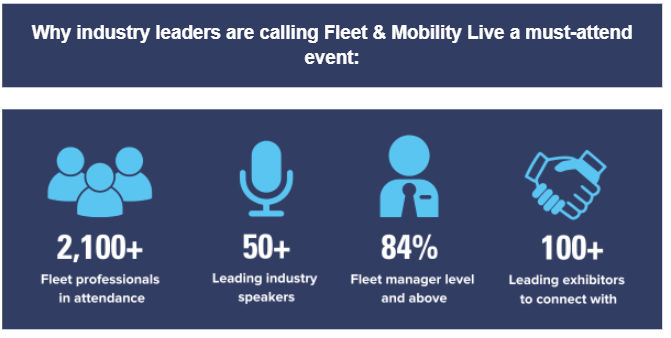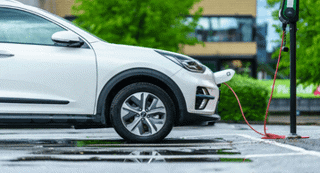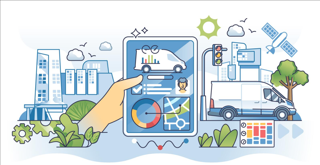Bridgestone Mobility Solutions has put sustainability at the core of its product development as it strives to meet the challenges fleets are facing today and in the future.
Marking 25 years of Webfleet, its global fleet management solution, at its Amsterdam office, Bridgestone Mobility Solutions outlined how the market is changing and how it is using data to adapt to that change.
Webfleet is currently used by more than 60,000 business globally to drive fleet efficiencies, boost safety, stay compliant and work more sustainably.
Jan-Maarten de Vries, president of fleet management solutions at Bridgestone Mobility Solutions, told Fleet News: “Sustainability is at the heart of everything we do and our mission is to create sustainable mobility solutions with the help of data.”
He highlighted how telematics has evolved over the past 25 years from simple vehicle tracking to the powerful fleet and data management solutions offered today.
In terms of what’s next for the business, he said that sustainability, driven by the adoption of electric vehicles (EVs) and artificial intelligence (AI), will have a “profound impact on fleet management solutions and telematics”.
For example, the development of a “digital twin” for fleet managers enabled by AI will be offered by Bridgestone Mobility Solutions within the next two years.
“Fleet managers don’t have the time to review thousands of alerts, thousands of insights to make a decision,” said Raghunath Banerjee, vice president of data solutions at Bridgestone Mobility Solutions.
“Informed decision-making is becoming complicated, because of the enormous volumes of data, that’s where we feel that AI has a very specific role to play.”
“Telematics is fundamentally about addressing the core needs and pain points of fleets,” Jan-Maarten de Vries, Bridgestone Mobility Solutions.
In a survey conducted by Bridgestone Mobility Solutions, a third (32%) of the fleets surveyed said that they expect AI and machine learning will have the biggest impact on fleet management in the next five years.
“What has not changed throughout the years, is that telematics is fundamentally about addressing the core needs and pain points of fleets by providing fleet management solutions and providing a return on investment for fleets,” explained de Vries.
Bridgestone’s survey of 1,800 fleet decision-makers across 15 countries including the UK, showed that 91% of fleet managers expect their investment in digital fleet solutions to increase in the next years.
More than half (52%) of respondents cited reducing operational costs and improving efficiency as the most compelling reason for investing in digital solutions for their fleet operation.
“Key to all of this is the use of data, because connected data plays a key role in delivering on the use cases of today… and will play an even more important role thinking about the use cases of tomorrow,” said de Vries.

Bridgestone's offices at the Valley in Amsterdam, a mixed-use development that includes 200 apartments, offices, restaurants, a breathtaking atrium and a publicly accessible park designed by landscape architect, Piet Oudolf.
Today, de Vries explained that fleets are employing telematics to improve fuel efficiency, improve drive safety and optimising the lifetime of the vehicle as well as CO2 reporting and compliance thanks to actionable insights.
In terms of tomorrow, he said: “Think of fleet orchestration, this is about applying your whole fleet in your business operations in a very efficient and effective way.
“Think of sustainability in the widest sense of the word, not just CO2 emissions. Think of balancing supply and the amount of energy.
“Think of control towers, which are there to respond and anticipate dynamic events in your business operations, unexpected events, and think of load sharing, which should be one of the solutions to the current big issue of empty mileage, empty trucks, empty trailers in transport and logistics sector.”
Bridgestone says that there will always be multiple providers required to deliver on the wide set of use cases that are addressing the challenges of the fleet's today and tomorrow.
“What is very important is the integration and seamless data sharing between those different mobility solution providers,” said de Vries. “Partnerships in the wider ecosystem become very essential.”
Optimising EV operations
Bridgestone Mobility Solutions launched a new platform connecting fleets with a network of service providers to optimise EV operations at the Consumer Electronics Show (CES) in Las Vegas at the start of the year.
The system aims to enable fleets to access a wide range of EV services easier, faster and with a lower cost of integration, accelerating electrification and optimising EV operations.
It creates a connection between these service providers based on fleet and energy data provided by Webfleet.
Bridgestone explained that the platform organises its services into six key pillars, which aims to make it easy for fleets to choose the ideal combination for their specific EV goals.
These include, a charging hardware and software pillar, with experts able to provide charging infrastructure according to a fleet’s needs, as well as monitoring and analysing the performance of chargers.
The smart charging pillar aims to reduce costs by avoiding peak loads and high energy tariffs, and lower emissions by utilising renewable energy.
In terms of energy management, fleets will also receive guidance on energy infrastructure and efficient energy management for your vehicles and buildings.
A battery analytics pillar aims to ensure fleet safety and reliability with alerts for battery issues, while improving the residual values of vehicles with reports on battery health.
A planning pillar, meanwhile, will help fleets plan orders and consider energy, charging, battery, and route constraints.
Finally, a fleet management pillar aims to enable fleets to run EV operations reliably and optimally based on real-time vehicle data and insights on driver behaviour and energy consumption.
“As businesses across the world step up to cut carbon emissions, electrification is top of mind for many fleets,” said Taco Olthoff, EV programme director at Bridgestone Mobility Solutions, when the new service was launched.
“But the route to electrification comes with challenges – high investments, maintaining a reliable operation and optimising your business to increase range and cut costs.
“These issues can only be solved when the energy and mobility industry collaborate.”
Olthoff explained that “seamless data exchange” is the missing link, which unlocks the full value that energy and mobility service providers can deliver by integrating their systems much closer.

“Data from connected vehicles can be shared with all those partners to not only help fleets through the transition to electric vehicles, but also to manage their operations in a reliable way and to optimise their total cost of ownership by providing solutions,” continued de Vries.
For instance, that could be smart charging at times of the day when the tariffs are lower or when the vehicles actually have the time to get charged.
He added: “It also offers solutions like smart battery management, which will become more important in the future because the battery becomes such a big cost factor in the vehicle and you need to manage the lifetime of the battery and the optimisation for the battery the better.”
Data key to fleet CO2 reporting
Richard Parker, EV Consultant for Bridgestone Mobility Solutions, says it is a question of ‘what can I do tomorrow and how can I plan for the future?’.
“It’s easy to do the tomorrow piece, because it’s things fleets have done for the past 20 years, things that telematics and data has delivered.
“It’s route optimisation, it’s driving behaviour around the right foot. It’s payload, it’s tyre pressures.
“If you can improve the MPG of your vehicle, if you can take a mile out of trip, you will affect the carbon footprint.”
The growing requirement for companies to report greenhouse gas (GHG) emissions, defined as Scope 1, 2 and 3, is having an impact on the needs to measure environmental impact of fleet operations.
“By getting the data we can help and support fleet managers make better decisions,” Taco van der Leij, Webfleet Europe
Scope 1 covers emissions from sources that an organisation owns or controls directly – for example from burning fuel in fleet of vehicles (if they are not electrically-powered).
Scope 2 are emissions that a company causes indirectly and come from where the energy it purchases and uses is produced.
For example, the emissions caused when generating the electricity that are used in buildings would fall into this category.
Scope 3 encompasses emissions that are not produced by the company itself and are not the result of activities from assets owned or controlled by them, but by those that it is indirectly responsible for up and down its value chain.
Essentially, it includes all sources not within the scope 1 and 2 boundaries.
Parker explains that this can be a daunting task for fleet decision-makers. “I’ve talked to a couple of organisations where they both said it took one person a month to pull it all together, because the data is collected through spreadsheets,” he said.
“It’s mileage report or it's a fuelcard; it's really quite a cumbersome way of doing it.”
The Webfleet CO2 Report gives organisations an accurate overview of their fleet’s direct CO2 emissions.
Using a methodology that is officially certified, it provides detailed information on how much CO2 vehicles produce as well as giving a fleet visibility over how, where and why vehicles are producing unnecessary CO2.
Taco van der Leij, vice president for Webfleet Europe at Bridgestone Mobility Solutions, said: “By getting the data we can help and support fleet managers make better decisions, and help them manage this huge amount of change.”
Parker concluded: “We are acutely aware of the role that we play in decarbonisation and our commitment at a Bridgestone level, never mind a Bridgestone Mobility Solutions level, is to keep on investing and getting the right insights out there for customers.
“That sounds very corporate, but it’s to that point my role exists because we have to feed in the problems that are arising. They're not the same problems that were there yesterday.
“It’s a real understanding that things are changing quickly, and we need to be able to react quickly.”


























Login to comment
Comments
No comments have been made yet.